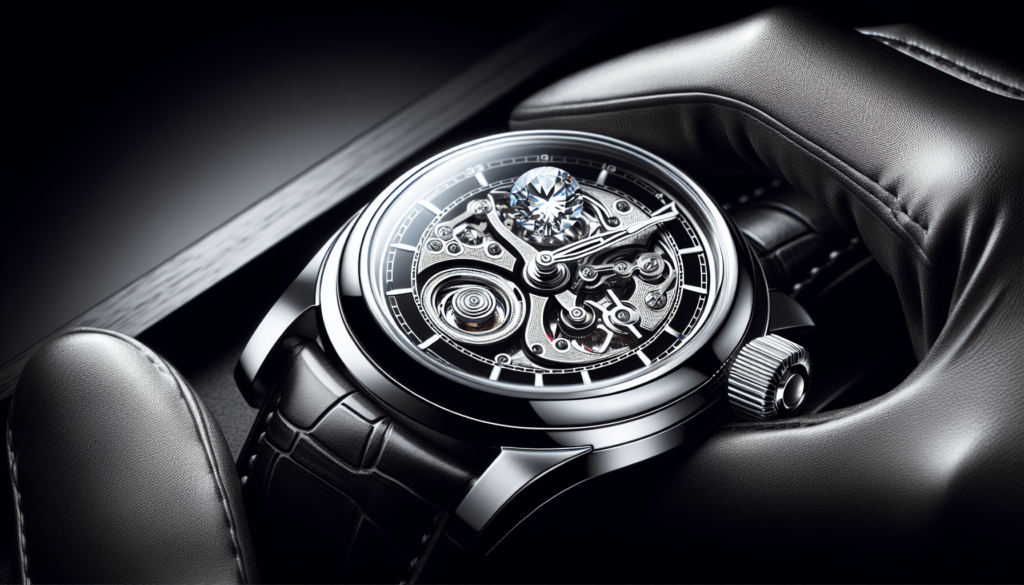
Luxury watchmaking is an art that combines tradition, precision, and exquisite craftsmanship. To create timepieces that exude elegance and exclusivity, watchmakers carefully select from a range of high-quality materials. From precious metals like gold and platinum to innovative alloys and ceramic, these materials not only enhance the aesthetics of luxury watches but also contribute to their durability and longevity. In this article, you will discover a fascinating array of materials commonly employed in the creation of luxurious timepieces, each playing a vital role in the creation of these horological masterpieces.
Metals
In the world of luxury watchmaking, metals play a crucial role in creating timepieces that are not only stunning in their design but also durable and long-lasting. Some of the most commonly used metals in luxury watchmaking include gold, platinum, and titanium.
Gold
Gold has been a symbol of luxury and prestige for centuries, and its incorporation into luxury watches is no exception. The warm hue of gold adds a touch of elegance and sophistication to any timepiece. Gold watches are often crafted using 18k gold, which contains 75% pure gold and offers a perfect balance between durability and purity.
Platinum
Platinum is a rare and precious metal that has become increasingly popular in the world of luxury watchmaking. Its dense and heavy nature gives watches made from platinum a unique weight and feel on the wrist. Platinum is also highly resistant to corrosion and tarnish, making it an excellent choice for those seeking a durable and low-maintenance timepiece.
Titanium
Titanium is another metal that has gained popularity in luxury watchmaking due to its exceptional strength-to-weight ratio. It is significantly lighter than stainless steel but equally strong, making it a comfortable option for everyday wear. Titanium watches are known for their sleek and contemporary designs, often appealing to those with a more modern and sporty aesthetic.
Stainless Steel
Stainless steel is a highly versatile metal commonly used in luxury watchmaking. It is known for its durability, resistance to corrosion, and classic aesthetic. Two types of stainless steel, 316L stainless steel and 904L stainless steel, are particularly prominent in luxury watches.
316L Stainless Steel
316L stainless steel is a popular choice for watch cases and bracelets due to its exceptional anti-corrosive properties. This low carbon stainless steel is highly resistant to rust and can withstand even the harshest environments. Watches made from 316L stainless steel are not only functional but also have a timeless and elegant appearance.
904L Stainless Steel
904L stainless steel is a higher grade of stainless steel known for its superior corrosion resistance. It is often used in high-end luxury watches, particularly those produced by Rolex. Watches made from 904L stainless steel are more expensive than those made with 316L stainless steel due to the increased complexity involved in working with this specific alloy.

Precious Stones
Precious stones add a touch of glamour and extravagance to luxury watches. Often used as hour markers, bezels, or even as a complete dial, diamonds, sapphires, emeralds, and rubies are among the most sought-after stones in the world of watchmaking.
Diamonds
Diamonds are synonymous with luxury and opulence. Their brilliance and durability make them a perfect choice for luxury watch embellishments. Diamond-set timepieces often feature meticulously placed stones that create a stunning visual display, adding a sense of prestige and luxury to any watch.
Sapphires
Sapphires, with their vivid blue color, are a popular gemstone choice for luxury watches. They are known for their hardness and scratch resistance, making them ideal for watch crystals. Sapphires can also be found in various colors, including pink, yellow, and green, offering a wide range of options for watch enthusiasts seeking a unique and vibrant timepiece.
Emeralds
The vibrant green hue of emeralds is both captivating and incredibly rare. Emeralds are highly valued gemstones that bring a sense of elegance and sophistication to luxury watches. Their unique color and natural beauty make them a popular choice for high-end timepieces.
Rubies
Rubies, with their deep red color, add a touch of passion and drama to luxury watches. The intensity and richness of the ruby make it a sought-after gemstone in watchmaking. Rubies are often used as accents or as a focal point on watch dials and bezels, adding a bold and luxurious statement to the overall design.
Ceramics
Ceramic materials have become increasingly popular in luxury watchmaking due to their exceptional durability, scratch resistance, and hypoallergenic properties. Zirconium oxide and titanium carbide are two types of ceramics commonly used in high-end watches.
Zirconium Oxide
Zirconium oxide, also known as zirconia ceramic, is prized for its impressive hardness and resistance to scratches. Many luxury watch brands use zirconium oxide to create watch cases, bezels, or even as an alternative to traditional metal bracelets. The smooth and lustrous surface of zirconium oxide adds a modern and sleek touch to luxury timepieces.
Titanium Carbide
Titanium carbide, also known as titanium nitride ceramic, is a material that combines the lightweight properties of titanium with the exceptional hardness of ceramic. This ceramic coating is applied to stainless steel watch components, such as bezels or crowns, to enhance their scratch resistance and add a striking black color to the overall design.

Carbon Fiber
Carbon fiber is a lightweight and robust material that has gained popularity in luxury watchmaking for its modern and sporty aesthetic. Used primarily in the creation of watch cases and dials, carbon fiber offers excellent shock resistance and durability. It is often seen in high-performance and sports-oriented watches, adding a touch of innovation and adventure to the timepiece.
Leather
Leather straps are a classic choice for luxury watches, offering a timeless and sophisticated look. Depending on the type of leather used, the strap can add a sense of elegance or a more rugged appeal to the watch.
Crocodile Leather
Crocodile leather is highly prized for its unique grain pattern and luxurious appearance. The distinctive scales and texture create a visually striking strap that exudes refinement and sophistication. Crocodile leather straps are often associated with high-end timepieces, adding a touch of exclusivity and prestige to the overall design.
Alligator Leather
Alligator leather is similarly sought-after for its beauty and durability. The softer scales and grain pattern of alligator leather can lend a more understated and subtle elegance to luxury watches. Alligator leather straps are often favored by watch enthusiasts looking for a sophisticated yet versatile option.
Calfskin Leather
Calfskin leather is a more affordable yet equally stylish choice for luxury watch straps. It is known for its softness and versatility, offering comfortable wear while maintaining a refined appearance. Calfskin leather straps come in various colors and finishes, allowing for a wide range of customization options to match different watch styles and personal tastes.

Fabrics
Fabrics, such as nylon, denim, and canvas, have found their way into luxury watchmaking, adding a casual and contemporary element to timepieces. These materials are often used in sporty or more casual watch designs.
Nylon
Nylon straps are lightweight, durable, and highly versatile, making them an excellent choice for sports watches. The breathable nature of nylon ensures comfort even during physical activities. Nylon straps come in a variety of colors and patterns, allowing for endless customization possibilities.
Denim
Denim straps bring a unique and casual charm to luxury watches. The timeless appeal of denim paired with the precision of watchmaking creates an intriguing juxtaposition of ruggedness and refinement. Denim straps can add a touch of personality and individuality to any timepiece.
Canvas
Canvas straps provide a laid-back and relaxed look to luxury watches. The rugged and textured nature of canvas lends itself well to more outdoor-oriented watch styles. Canvas straps are often associated with military-inspired designs, offering a sense of adventure and durability.
Sapphire Crystal
Sapphire crystal is a highly transparent and scratch-resistant material commonly used to protect the dial of luxury watches. It offers excellent clarity and enhances the overall aesthetics of a timepiece. Sapphire crystal is incredibly durable, making it highly resistant to scratches and scuffs, ensuring a pristine appearance for years to come.

Mother-of-Pearl
Mother-of-pearl is a natural material with a captivating iridescent quality, often used as a dial or as an accent in luxury watches. The delicate and shimmering appearance of mother-of-pearl creates a visually stunning effect, adding a touch of elegance and femininity to timepieces. With its unique luster and variety of colors, mother-of-pearl offers endless design possibilities for watchmakers.
Rubber
Rubber straps have gained popularity for their comfort, durability, and versatility. Often seen in sports watches and dive watches, rubber straps provide flexibility and resistance to water and harsh conditions. They offer a comfortable fit and can withstand rigorous activities, making them an ideal choice for those with an active lifestyle.
In conclusion, luxury watches are crafted using a wide array of materials, ranging from precious metals like gold and platinum to high-tech ceramics, precious stones, and exquisite leathers. Each material brings its own unique characteristics and contributes to the overall design and durability of the timepiece. The fusion of these materials and the meticulous craftsmanship of watchmakers result in remarkable timepieces that embody luxury, sophistication, and timeless elegance.